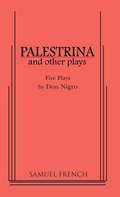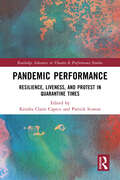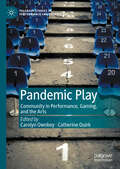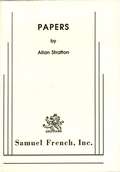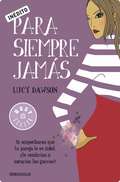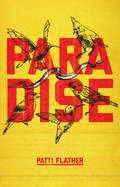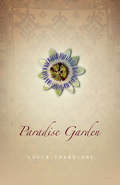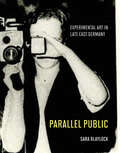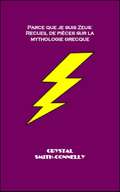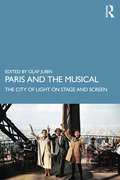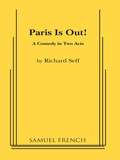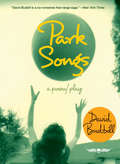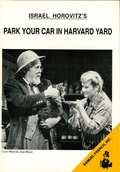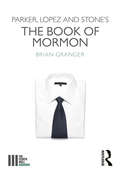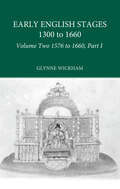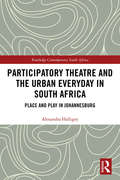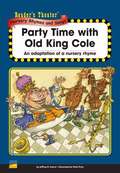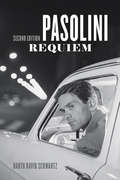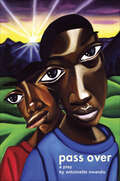- Table View
- List View
Palestrina and Other Plays
by Don NigroDemonology, MacNaughton's Dowry, Netherlands, The Bohemian Seacoast
Pandemic Performance: Resilience, Liveness, and Protest in Quarantine Times (Routledge Advances in Theatre & Performance Studies)
by Kendra Claire CapecePandemic Performance chronicles the many ways that people are surviving/thriving through performance in a global pandemic. Covering artists and events from across the United States: from New York to California and from South Dakota to Texas, the chapters are equal parts theory and practice, weaving scholarship with personal experience from contributors who are interdisciplinary artists, scholars, journalists, and community organizers providing unique and invaluable perspectives on the complicated work of resilience during COVID-19. This study will hold interest for students and scholars in the performing arts, arts, and social justice as well as professional artmakers and creative community organizers.
Pandemic Play: Community in Performance, Gaming, and the Arts (Palgrave Studies in Performance and Technology)
by Carolyn Ownbey Catherine QuirkWhen the arts, culture, and entertainment industries came to a halt in late winter 2020, many claimed this was the end of art as we knew it. Theatre managers, museum directors, performers, artists, and everyday folks had to figure out new strategies for living and thriving in a new world order. As the global pandemic and its consequences continue to play out, the question of how we have learned—as creators or consumers—to play, is far from settled. This collection addresses pandemic play in broad terms: how did creative industries adapt to a majority virtual world? How have our understandings of community and play evolved? Might new forms of art and play outlive the pandemic and supplant earlier iterations? Pandemic Play takes these questions as a starting point, exploring strategies, case studies, and effects of the arts worlds gone virtual.
Paper Tigers
by Damien Angelica WaltersIn this haunting and hypnotizing novel, a young woman loses everything-half of her body, her fiancé, and possibly her unborn child-to a terrible apartment fire. While recovering from the trauma, she discovers a photo album inhabited by a predatory ghost who promises to make her whole again, all while slowly consuming her from the inside out.Damian Angelica Walters' work has appeared or is forthcoming in Year's Best Weird Fiction Volume One, Nightmare, Strange Horizons, Lightspeed, Shimmer, Apex, and Glitter & Mayhem. She was an associate editor of the Hugo Award-winning Electric Velocipede.
Papers
by Allen StrattonComedy / 1m, 2f / Interior / This inventive romantic comedy with a novel twist is by the author of Nurse Jane Goes to Hawaii and Bingo . Professor Moira Fitzsimmons is lecturing about a novel by her colleague Martin Edwards. Her hilarious version of the love affair that inspired the novel constitutes the bulk of this sophisticated light comedy. Just as the autobiographical characters in the novel reach a loving resolution, it is revealed that Moira and Martin are happily married, and that the preceding lecture actually outlines the novelist latest book.
Para siempre jamás
by Lucy DawsonLa pasión, el entusiasmo y la espontaneidad que definen el comienzo de una relación se desvanecen con el paso del tiempo. Pero a Mia no le preocupa, porque sabe que el amor que siente por Pete será duradero. La experiencia le dicta que las relaciones requieren de un esfuerzo y un cuidado diario; este es el secreto para que una relación adulta funcione.Pero una noche, de camino al baño, encuentra el teléfono de Pete y lee un mensaje de texto que le deja la sangre helada: todo apunta a que tiene una amante. Mia tendrá que ponerse seria y sacar todas sus armas de mujer, incluso algunas que ni tan siquiera sabía que tenía.Después de todo, su felicidad está en juego, ¿no?«Lucy Dawson ha sabido dar forma a la pesadilla de toda mujer. Os identificaréis con el personaje aun a pesar de las decisiones que termine tomando, sentiréis su pesar, os saltaréis páginas por la impaciencia# y os dejará con un nudo en el estómago.»Heat
Paradise
by Patti FlatherAfter a traumatic assault in Central America, Rachel returns home, but it isn’t the reprieve she expected. She comes back to turmoil between her parents, and a part-time job in her dad’s medical office. Her father, George, full of endearing blunder, tries unsuccessfully to connect with his daughter, who seems to be reeling. Her childhood friend Khalil isn’t around to provide support. He’s in Afghanistan travelling and volunteering when he is wrongfully arrested. On the periphery is Wally—off work because of a logging injury—who spends a great deal of time in George’s office. Wally struggles to buy food for his dog Lucky, his rent payments are overdue, and the ringing in his ears just won’t stop. He’s looking for help in all the right places, but nobody seems to notice he’s deteriorating until it’s too late.
Paradise Garden
by Lucia FrangioneIn the gold-rush era of the 1850s, the McKinnons settled on an island off the west coast of Canada, where the first thing they did was to turn this "wilderness" into an English country garden complete with vegetables, flowers, fruit trees and an elegant gazebo. After six generations, times and circumstances have changed, the family estate has been subdivided, the flowers have gone wild, the pear-tree has rotted and the heritage house has been carved up into a duplex, the property now divided in two by an ugly hedge.The McKinnons now live in one side of the property, while the other has been sold to an immigrant family recently arrived from Turkey. The heirs apparent to both families, Day McKinnon and Leyla Zeki, fancy themselves to be sophisticated citizens of the world, tolerating with thinly disguised amusement their ancestors' "outdated" formalities and rituals. So alienated are they that they spend much of their time only half-jokingly speaking of themselves in the third person. Yet Leyla recognizes something fundamental and mysterious in the vestiges of the old garden: its tumbled and overgrown ruins remind her of the Paradise Garden of Judeo-Christian/Islamic tradition-its layout in the four cardinal directions, its allusions to the seasons and the elements, and its walls that surround a place of secret love. For Day, however, despite, or perhaps because of the fact that he has discovered a long-buried family secret, "The problem with being born into paradise is: eventually you inherit it. There's something to be said for the bedlam of hell. Heaven is a lot of upkeep." Abandoning their families for their careers, they are reunited years later having discovered that love is not just something that happens to us, but something that we must build by hand in the wilderness of our lives.
Paradise Lost
by John Milton Paul Stevens Erin Shields“The biggest mistake any of us could make would be to underestimate Satan.” The seventeenth century and present day are seamlessly intertwined as Satan vents to an audience about her frustration at being cast out of Heaven and her thoughts on oppression. When she finds out that God has created delicate new creatures called “humans,” she crafts a plan for revenge and betrayal on the Almighty. Erin Shields turns Heaven and Hell upside down in this witty, modern, feminist retelling of John Milton’s epic poem about the first battle between good and evil. Shields’s wickedly smart and funny script questions the reasons of the universe, the slow process of evolution and the freedom of knowledge. The debate over right and wrong has never been so satisfying.
Parallel Public: Experimental Art in Late East Germany
by Sara BlaylockHow East German artists made their country&’s experimental art scene a form of (counter) public life.Experimental artists in the final years of the German Democratic Republic did not practice their art in the shadows, on the margins, hiding away from the Stasi&’s prying eyes. In fact, as Sara Blaylock shows, many cultivated a critical influence over the very bureaucracies meant to keep them in line, undermining state authority through forthright rather than covert projects. In Parallel Public, Blaylock describes how some East German artists made their country&’s experimental art scene a form of (counter) public life, creating an alternative to the crumbling collective underpinnings of the state. Blaylock examines the work of artists who used body-based practices—including performance, film, and photography—to create new vocabularies of representation, sharing their projects through independent networks of dissemination and display. From the collective films and fashion shows of Erfurt's Women Artists Group, which fused art with feminist political action, to Gino Hahnemann, the queer filmmaker and poet who set nudes alight in city parks, these creators were as bold in their ventures as they were indifferent to state power. Parallel Public is the first work of its kind on experimental art in East Germany to be written in English. Blaylock draws on extensive interviews with artists, art historians, and organizers; artist-made publications; official reports from the Union of Fine Artists; and Stasi surveillance records. As she recounts the role culture played in the GDR&’s rapid decline, she reveals East German artists as dissenters and witnesses, citizens and agents, their work both antidote to and diagnosis of a weakening state.
Paratexts in English Printed Drama to 1642
by Thomas L. Berger Sonia MassaiThe paratexts in early modern English playbooks the materials to be found primarily in their preliminary pages and end matter provide a rich source of information for scholars interested in Shakespeare, Renaissance Drama and the History of the Book. In addition, these materials offer valuable insights into the rise of dramatic authorship in print, early modern attitudes towards theatre, notorious literary wrangles and the production of drama both on the stage and in the printing house. This unique two-volume reference is the first to include all paratextual materials in early modern English playbooks, from the emergence of print drama to the closure of the theatres in 1642. The texts have been transcribed from their original versions and presented in old-spelling. With an introduction, user's guide, multiple indices and a finding list, the editors provide a comprehensive overview of seminal texts which have never before been fully transcribed, annotated and cross-referenced. "
Parce que je suis Zeus: Recueil de pièces sur la mythologie grecque.
by Mandy Bernardini Crystal Smith-ConnellyParce que je suis Zeus: Recueil de pièces sur la mythologie grecque contient six courtes pièces sur le plus divertissant des dieux grecs. Suivez Zeus lorsqu'il souffre pendant une thérapie de couple, fait une proposition indécente à ses sœurs ou essaie de coucher avec tout ce qui bouge.
Paris and the Musical: The City of Light on Stage and Screen
by Olaf JubinParis and the Musical explores how the famous city has been portrayed on stage and screen, investigates why the city has been of such importance to the genre and tracks how it has developed as a trope over the 20th and 21st centuries. From global hits An American in Paris, Gigi, Les Misérables, Moulin Rouge! and The Phantom of the Opera to the less widely-known Bless the Bride, Can-Can, Irma la Douce and Marguerite, the French capital is a central character in an astounding number of Broadway, Hollywood and West End musicals. This collection of 18 essays combines cultural studies, sociology, musicology, art and adaptation theory, and gender studies to examine the envisioning and dramatisation of Paris, and its depiction as a place of romance, hedonism and libertinism or as ‘the capital of the arts’. The interdisciplinary nature of this collection renders it as a fascinating resource for a wide range of courses; it will be especially valuable for students and scholars of Musical Theatre and those interested in Theatre and Film History more generally.
Paris is Out!
by Richard SeffHortense and Daniel, a married couple of over 40 years, plan to embark on their first European vacation, but the two have very different outlooks on travel. Daniel is convinced he will be unimpressed by the other side of the pond. His conditions for the trip are: no Paris, no Venice, no shopping, sightseeing, or speaking in French. Hortense, on the other hand, is full of life and eager to experience Europe fully. When Daniel embarrasses Hortense in front of family and friends, she announces that the trip is cancelled. As her adult children try to convince her to forgive Daniel, Hortense must decide how she feels about the man with whom she has shared a life for 40 years. Daniel, in turn, to save his marriage must show how much he appreciates Hortense.
Park Songs
by David Budbill R. C. IrwinA "tale of the tribe" (Ezra Pound's phrase for his own longer work), Park Songs is set during a single day in a down-and-out Midwestern city park where people from all walks of life gather. In this small green space amidst a great gray city, the park provides a refuge for its caretaker (and resident poet), street preachers, retirees, moms, hustlers, and teenagers. Interspersed with blues songs, the community speaks through poetic monologues and conversations, while the homeless provide the introductory chorus--and all of their voices become one great epic tale of comedy and tragedy. Full of unexpected humor, hard-won wisdom, righteous (but sometimes misplaced) anger, and sly tenderness, their stories show us how people learn to live with mistakes and make connections in an antisocial world. As the poem/play engages us in their pain and joy--and the goofy delight of being human--it makes a quietly soulful statement about acceptance and community in our lives. David Budbill has worked as a carpenter's apprentice, short order cook, day laborer, and occasional commentator on NPR's All Thing Considered. His poems can often be heard on Garrison Keillor's Writer's Almanac and his books include the best-selling Happy Life (Copper Canyon Press) and Judevine, a collection of narrative poems that forms the basis for the play Judevine, which has been performed in twenty-two states. Born in Cleveland, Ohio, Budbill now lives in the mountains of northern Vermont. R. C. Irwin, whose absurdist and nostalgic work provides the set design for Park Songs, teaches at San Francisco City College.
Park Your Car in Harvard Yard
by Israel HorovitzDramatic Comedy / 1f, 1m / Interior / One of the author's acclaimed Gloucester based plays. This resounding success throughout America and Europe, starred Judith Ivey and Jason Robards on Broadway. A hilarious and deeply moving tale about the toughest, meanest teacher to ever set foot in Gloucester High School. Now Jacob Brackish is dying. He advertises for a housekeeper to look after him during his final year and hires mousey, 40 year old Katherine Hogan, forgetting that he flunked Katherine ... and her mother and father ... and her recently deceased husband. Kathleen relishes the idea of watching Brackish suffer, but, as his final year passes, memories inspire revelations that redefine the nature of their lives.
Parker, Lopez and Stone's The Book of Mormon (The Fourth Wall)
by Brian Granger'Hasa Diga Eebowai' In 2011, a musical full of curse words and Mormon missionaries swept that year’s Tony Awards and was praised as a triumphant return of the American musical. This book explores the inherent achievements (and failures) of The Book of Mormon—one of the most ambitious, and problematic, musicals to achieve widespread success. The creative team members—Matt Parker, Trey Stone and composer Robert Lopez—were collectively known for their aggressive use of taboo subjects and crude, punchy humor. Using the metaphor of boxing, Granger explores the metaphorical punches the trio delivers and ruminates over the less-discussed ideological wounds that their style of shock absurdism might leave behind. This careful examination of where The Book of Mormon succeeds and fails is sure to challenge discussion of our understanding of musical comedy and our appreciation for this cultural landmark in theatre.
Part I - Early English Stages 1576-1600
by Glynne WickhamThis volume forms part of the 5 volume set Early English Stages 1300-1660. This set examines the history of the development of dramatic spectacle and stage convention in England from the beginning of the fourteenth century to 1660.
Part II - Early English Stages 1576-1600
by Glynne WickhamThis volume forms part of the 5 volume set Early English Stages 1300-1660. This set examines the history of the development of dramatic spectacle and stage convention in England from the beginning of the fourteenth century to 1660.
Part-Time Marriage
by Jessica SteeleCould she become his part-time wife?How could Elexa stop her family bugging her about finding a "nice" man to marry? Right now, she wanted to concentrate on her career. The solution arrived in the shape of wealthy businessman Noah Peverelle, who wanted a son, but who had no time for emotional entanglements. Impulsively Elexa accepted when Noah proposed.But their convenient, part-time marriage wasn't working out as planned. For one thing, Elexa made the mistake of falling in love with her husband....
Participatory Theatre and the Urban Everyday in South Africa: Place and Play in Johannesburg (Routledge Contemporary South Africa)
by Alexandra HalligeyThis book explores theatre and performance as participatory research practices for exploring the everyday of the city. Taking an inner-city suburb of Johannesburg, South Africa as its central case study, the book considers how theatre and performance might be both useful practical tools in considering the everyday city, as well as conceptual lenses for understanding it. The author establishes an understanding of space as ever evolving and formed through the ongoing relationship between things, human and non-human, and considers how theatre and performance offer useful paradigms for learning about and working with city spaces. As ephemeral, embodied, material artistic practices, theatre and performance mirror the nature of everyday life. The book discusses theatre and performance games and placemaking processes as offering valuable ways of discovering daily acts of place-making and providing insights that more conventional research methods may not allow. Yet the book also considers how seeing daily city life as a kind of performance, a kind of theatre in its own right, helps to further understandings of city spaces as ever evolving through complex webs of relationships. This book will be of interest to academics, academic practitioners and post-graduate students in the fields of theatre and performance studies, urban studies and cultural geography.
Partners of the Imagination: The Lives, Art and Struggles of John Arden and Margaretta D’Arcy
by Robert LeachPartners of the Imagination is the first in-depth study of the work of John Arden and Margaretta D’Arcy, partners in writing and cultural and political campaigns. Beginning in the 1950s, Arden and D’Arcy created a series of hugely admired plays performed at Britain’s major theatres. Political activists, they worked tirelessly in the peace movement and the Northern Ireland ‘Troubles’, during which D’Arcy was gaoled. She is also a veteran of the Greenham Common Women’s Peace camp. Their later work included Booker-listed novels, prize-winning stories, essays and radio plays, and D’Arcy founded and ran a Woman’s Pirate Radio station. Raymond Williams described Arden as ‘the most genuinely innovative’ of the playwrights of his generation, and Chambers and Prior claimed that ‘The Non-Stop Connolly Show’, D’Arcy and Arden’s six-play epic, ‘has fair claim to being one of the finest pieces of post-war drama in the English language’. This study explores the connections between art and life, and between the responsibilities of the writer and the citizen. Importantly, it also evaluates the range of literary works (plays, poetry, novels, essays, polemics) created by these writers, both as literature and drama, and as controversialist activity in its own right. This work is a landmark examination of two hugely respected radical writers.
Party Time with Old King Cole: An Adaptation of a Nursery Rhyme
by Jeffrey B. FuerstNIMAC-sourced textbook
Pasolini Requiem: Second Edition
by Barth David SchwartzPier Paolo Pasolini (1922–75) was one of the most important Italian intellectuals of the post–World War II era. An astonishing polymath—poet, novelist, literary critic, political polemicist, screenwriter, and film director—he exerted profound influence on Italian culture up to his untimely death at the age of fifty-three. This revised edition of what the New York Times Book Review has called “the standard Pasolini biography” introduces the artist to a new generation of readers. Based on extensive interviews with those who knew Pasolini, both friends and enemies, admirers and detractors, Pasolini Requiem chronicles his growth from poet in the provinces to Italy’s leading “civil poet”; his flight to Rome in 1950; the scandalous success of his two novels and political writing; and his transition to film, where he started as a contributor to the golden age of Italian cinema and ended with the shocking Salò, or the 120 Days of Sodom. Pasolini’s tragic and still unsolved murder has remained a subject of contentious debate for four decades. The enduring fascination with who committed the crime—and why—reflects his vital stature in Italy’s political and social history. Updated throughout and with a new afterword covering the efforts to reopen the investigation—and the legal maelstrom surrounding Pasolini’s demise—this edition of Pasolini Requiem is a riveting account of one of the twentieth century’s most controversial, ever-present iconoclasts.
Pass Over: A Play
by Antoinette NwanduA startling play examining the cyclical ravages of racial injustice and violence on two young black men, by an extraordinary voice in American theater. Moses and Kitch stand around on the corner—talking shit, passing the time, and hoping that maybe today will be different. As they dream of their promised land, a stranger wanders into their space with his own agenda and derails their plans. Emotional and lyrical, Pass Over crafts everyday profanities into poetic and humorous riffs, exposing the unquestionable human spirit of young men stuck in a cycle that they are desperately trying to escape. Spike Lee directed a film version of the play that premiered at the 2018 Sundance Film Festival and South by Southwest, and was produced by Amazon Studios. A provocative riff on the Book of Exodus and Waiting for Godot, Pass Over is a remarkable work of politically-charged theater by a bold new American voice.Praise for Pass Over &“Searing. . . . Blazingly theatrical. . . . Moses and Kitch are a dispossessed team like [Beckett&’s] Vladimir and Estragon, stuck in an existential cycle of hopelessness they try to master with gallows humor and jags of deluded optimism. . . . Creates a vivid world of injustice while riffing on earlier. . . . Resonates as a powerful tragedy.&” ―New York Time &“Chilling. . . . Combines daring near-experimental form and brutal content: what&’s at work is not some mysterious cosmic existentialism à la Beckett, but very real, very tangible racism.&” ―New Yorker &“In the insanity of a city filled with guns, and people ready and willing to use them whenever temperatures rise, waiting isn&’t so much a malaise as a badge of survival. That&’s one of the takeaways of Antoinette Nwandu&’s Pass Over, a very potent and promising play. . . . The language in the work is thrilling, poetical.&” ―Chicago Tribune
